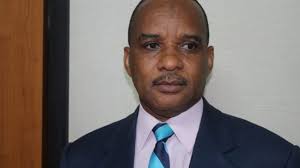

The 4th Anniversary of the book launch; Harnessing Nigeria’s Maritime Assets: Past, Present and Future authored by Dr. Bashir Yusuf Jamoh, the amiable Director General of the Nigerian Maritime Administration and Safety Agency (NIMASA), the apex Maritime regulatory and promotional agency in Nigeria is on 28th August 2022.
My passion for this book was enhanced not only because I am a Maritime Scholar and researcher, but also that I was featured in the book (via a picture taken together at an international Maritime function in Abuja) and a copy of the book autographed to me by the author, who is also a friend and a former colleague at Nimasa. This review is particularly significant at this time as the author by providence, fate or divine, and dint of hard work is the current DG of Nimasa, away from his previous position as Executive Director (Finance and Administration) at the time the book was published and launched. Further, this review provides a platform for an assessment of how the views and recommendations offered by the author have influenced policy, made a positive impact on the Nigerian Maritime sector and the economy. It has also portrayed how this has guided his performance as the DG NIMASA.
From the perspective of a well-informed contributor looking in, the book has been widely acknowledged and reviewed as one that takes the reader on an historical excursion, from the slave trade era, through the colonial period and anchoring in current realities. The book provides valuable insights essential to the achievement of optimum efficiency level of the agency in its core mandate of Maritime administration and safety. It also spills into other sectors like agriculture, metallurgy, tourism, and marine plastic waste technology for the total benefit of Nigeria’s economy.
The first chapter of the book opens with an introduction underlining the role and importance of Maritime transportation as a critical enabler of international trade and with its low-cost attribute. The prospective Maritime areas that were previously disregarded were also addressed. The outstanding six chapters of the book highlight the historical facts on the establishment of the modern port system in Nigeria and the identification of Nigeria’s Maritime assets. Further, the book also brings to the fore the institutional and regulatory framework that are critical to ensure good corporate governance, Maritime safety, security, and surveillance. The challenges in the Nigerian Maritime sector were also identified and a futuristic framework charted closing with recommendations and conclusions.
Personally, I believe this book provided Dr. Jamoh a road map and vision with which he is currently running the Maritime industry in Nigeria. Talk of preparedness meeting opportunity! According to Bobby Unser, “success is rarely a matter of luck. It is more a matter of preparation to put yourself in the path of opportunity”. This contention is demonstrated in the activities of Dr. Jamoh as the DG Nimasa. From the inception of his tenure as the 16th DG of Nimasa, he anchored his mission on a tripod of Maritime Security, Maritime Safety and Shipping development or the Triple ‘S’ (NIMASA Performance Tripod). The Triple ‘S’ is designed as the compass of the administration in charting the course of the Agency. Two and a half years into his administration, notable achievements can be articulated.
Under Maritime Security, the Deep Blue Project, (launched by President Muhammadu Buhari), is the first integrated Maritime security strategy in West and Central Africa, tackling the occurrences of piracy, sea robbery and other crimes at sea. The International Maritime Bureau (IMB) has also acknowledged and commended the overall reduction of piracy and armed robbery incidents in the Gulf of Guinea due to an enhanced Maritime security and response coordination.
The second leg of the tripod, Maritime Safety, enjoys a pride of place in the book. This tripod includes ship standards, crew and labour conditions, nautical charts, pollution prevention and control. In this segment, Nimasa has made significant inroads predominantly in the wreck removal projects, revival of operational boats, partnership with key stakeholders and the National Marine Plastic Plan.
The third leg of the tripod is Shipping Development. This tripod which is close to the heart of the author, deals with the development of shipping and regulatory matters relating to merchant shipping and seafarers where a lot still needs to be done particularly in the participation of indigenous shipping companies in the carriage of crude oil and favourable implementation of the Cabotage Act. Remarks must be made of the disbursement of the CVFF to Nigerian ship owners for possible re-fleeting.
Among several other reforms made by Dr. Jamoh and his Executive Management are ;
The operations of indigenous shipping companies;
Commissioning of Nimasa knowledge centre e-library;
The revitalization of the Nigerian seafarers’ development programme (NSDP) and a
Host of other positive achievements in the maritime domain.
In closing, Dr. Jamoh’s Harnessing Nigeria’s Maritime Assets with references and bibliography from credible sources, is a piece of work with excellent academic and industrial relevance written by a seasoned Maritime professional in a powerful, revealing, and thought-provoking style. This book will continue to be a reference source of information to the government, the Maritime industry, students, and the general public. Hopefully, as we sail into the future with optimism, the second edition of the book should be contemplated to update certain positions with the benefit of hand sight and experience as the helmsman of Nigeria’s premier Maritime regulatory and promotional agency, Nimasa.

